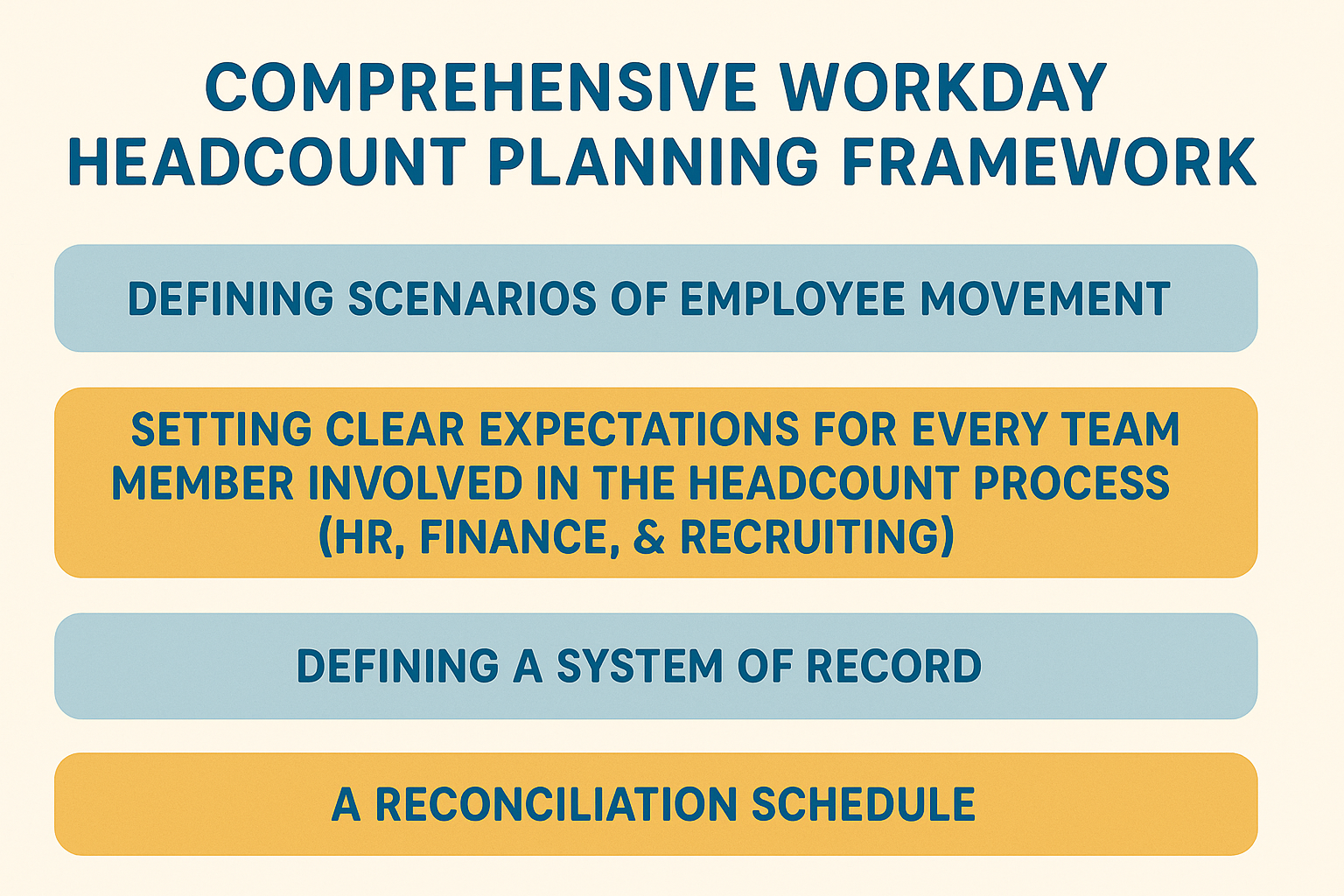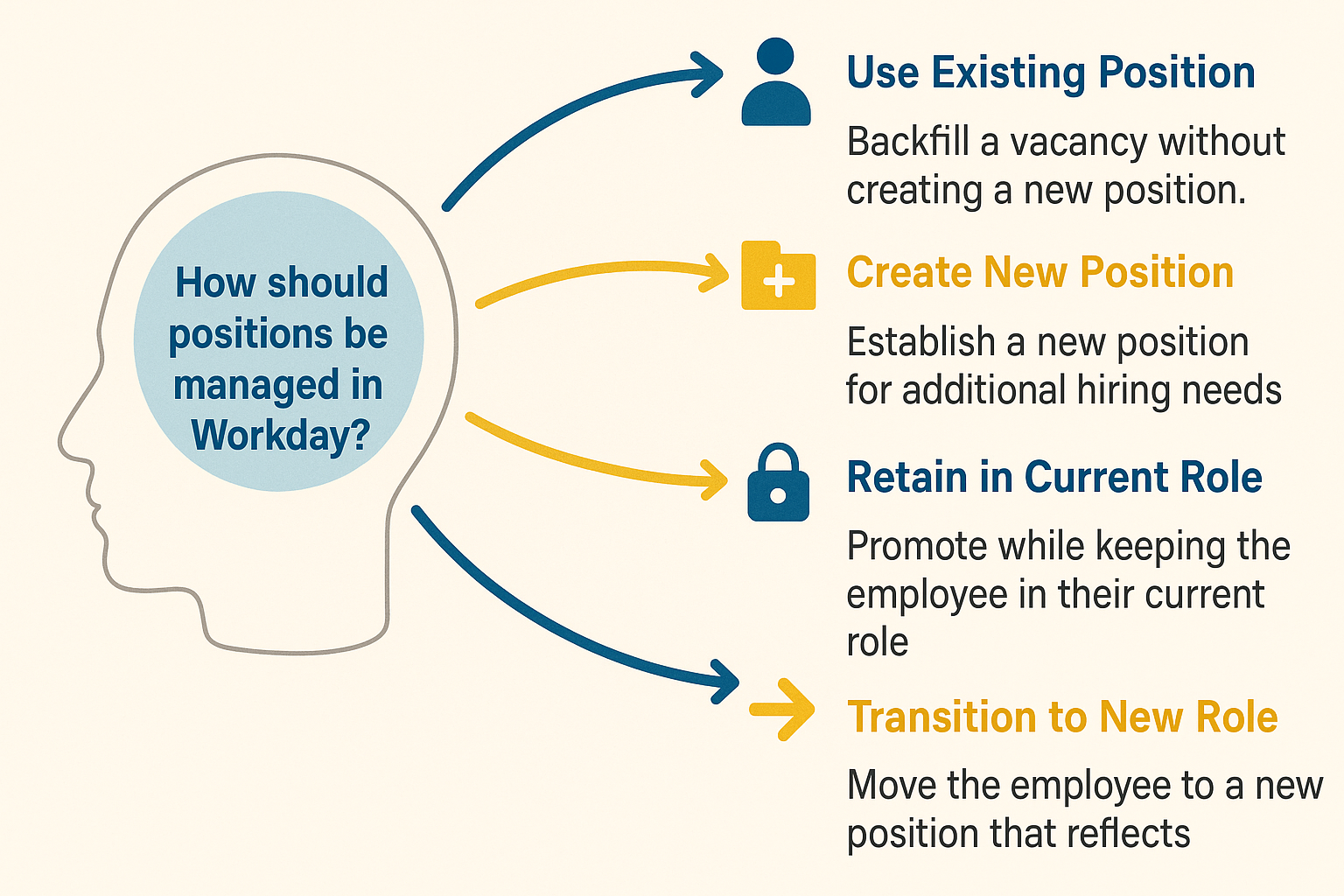5 Common Workday Headcount Management Mistakes (and How to Solve Them)
"Wait, didn't we already account for that role in the budget?" 🤔
"Finance says we don't have headcount approval, but Recruiting already started sourcing candidates…again." 🙄
"Why do our headcount numbers never match between HR, Finance, and Recruiting?" 😵💫
If these questions sound familiar, you're not alone.
During our 14+ years of experience in Workday implementations, we've seen even the most sophisticated organizations struggle with these kinds of Workday position management and Workday headcount management challenges. The troubling reality is that while most Workday customers implement robust planning processes, many still end up with fragmented systems, stale and outdated spreadsheets, and conflicting data.
But the good news is that it doesn't have to be that way.
We've identified the five most common headcount management mistakes that derail organizations—and more importantly, how to fix them. If you're a Workday customer, we hope these insights can help you transform overall headcount planning into a strategic advantage no matter where you are in your implementation journey.
Mistake #1: Having an Unclear Definition of Headcount Planning
One of the biggest and most common mistakes we see organizations make is not clearly defining what headcount planning means in their company. Headcount planning is the strategic process of forecasting, budgeting for, and managing your organization's workforce needs across systems and departments.
From our experience, it's HOW the headcount is managed that can make or break the entire process, and this applies both to pre-hire planning as well as throughout the employee lifecycle.
For example, how do you handle headcount during internal movement? You might define a promotion within the same department as a headcount-neutral event, while a transfer to another department might require headcount adjustments in both the sending and receiving departments.
If you're defining these scenarios and all other combinations of employee movement, document it and set clear expectations with every team member involved in the headcount process. That's how you set up your planning for success. While approaches may vary between organizations, consistency and a clear definition are what matter most.
The Problem
When you're tracking headcount across multiple systems and departments, things can get messy quickly. Many organizations get sucked into a black hole of data reconciliation instead of focusing on strategic workforce planning, all because headcount planning isn't clearly defined.
Your Finance, HR, and Recruiting teams should know exactly what to do in any scenario—from annual planning to incremental headcount requests, from new hires to terminations. Without clear definitions, everyone ends up doing something different, your headcount numbers diverge, and before you know it, you're spending more time on data cleanup than on strategic initiatives.
The Solution
Though unclear headcount planning can cause many problems, the fix is relatively straightforward—create a clear, comprehensive framework that defines:
Consistent terminology: Ensure everyone uses the same terms (approved headcount, open headcount, filled headcount, etc.) with the same definitions
Cross-functional protocols: Establish when and how headcount is requested, approved, and adjusted
System of record: Determine which system is the source of truth for different types of headcount data
Reconciliation schedule: Set regular intervals to align headcount data across systems
As an example, during your annual budgeting cycle, Finance might approve departmental headcount totals, but HR controls how that translates to actual positions in Workday. Meanwhile, Recruiting needs real-time visibility into which positions are approved for hiring.
Internal movements require even more clarity. When conducting promotions within a department, your framework should specify whether this impacts available headcount. For cross-department transfers, you need clear rules about how headcount is adjusted in both departments.
These processes should be clearly defined across all systems—from your financial planning software to Workday to your ATS—with clear guidelines for each team. When used correctly, comprehensive headcount planning facilitates strategic workforce management, accurate financial forecasting, and seamless recruiting execution.
Mistake #2: Treating Recruiting Systems in Isolation from Financial Planning
There are two critical components of headcount planning: budgeting/forecasting and recruiting execution. We've seen many organizations treat these as separate processes rather than parts of an integrated whole.
The Problem
When you need to fill a role, the typical process involves multiple handoffs:
Most companies integrate Workday with both a financial planning system and an Applicant Tracking System (ATS). That isn't bad in itself—in fact, it's necessary to facilitate the complete headcount planning process.
However, most organizations run into the same problem: they focus on these integrations separately rather than as parts of a unified headcount management process. Companies often build one integration between their financial planning system and Workday, and another between Workday and their ATS, without ensuring these systems talk to each other effectively.
Why is this problematic? Because when you're only concerned with point-to-point technical integrations, you miss the opportunity to build a unified headcount planning strategy and seamless headcount management tools to create a continuous flow of data. This leads to fragmented processes that waste time and create expensive mistakes like over-hiring or budget misalignment.
The Solution
Organizations should ask themselves these critical questions when approaching headcount planning:
How does the approved headcount in the financial planning system flow to Workday and the ATS?
What happens when Finance adjusts the budget mid-year? How do those changes propagate to Recruiting?
How are positions updated in Workday during the pre-hire process?
What process exists when a department needs additional headcount beyond the annual plan?
How are compensation changes during the recruiting process approved and reflected in financial forecasts?
What visibility does Finance have into hiring timelines to accurately forecast personnel expenses?
The lesson is clear: You should elevate the conversation from isolated system integrations to your entire headcount planning process. Modern headcount software can bridge these gaps, creating a single source of truth that keeps Finance, HR, and Recruiting aligned throughout the entire headcount lifecycle.
Mistake #3: A Lack of Clear Ownership and Accountability Across Departments
We've seen this third mistake wreak havoc on hundreds of organizations.
A lack of cross-functional ownership for your headcount planning process isn't just about confusion when headcount numbers don't match. It's specifically when Finance, HR, and Recruiting aren't aligned on roles and responsibilities, creating challenges around who approves headcount, who tracks it, and who can make adjustments.
The Problem
Headcount management involves many transactions across multiple systems.
However, if there's no accountability or headcount governance regarding:
Who owns headcount approval
Who tracks budget vs. actual headcount
Who monitors hiring progress
Who can adjust forecasts when timelines change
Who ensures data consistency across systems
...then the entire headcount planning process breaks down. Someone in HR might close a position that Finance still has budgeted, or Recruiting might continue sourcing for a role that's been put on hold due to budget constraints.
No matter the specific scenario, a lack of headcount governance and accountability can lead to mismatched headcount numbers, inaccurate forecasts, compliance risks, and even audit findings. We've seen organizations waste countless hours reconciling headcount data simply because multiple teams were making changes without communication or understanding of downstream impacts.
The Solution
We recommend a few tactics to keep your headcount planning process on track:
Establish a cross-functional headcount committee with representatives from Finance, HR, and Recruiting that meets regularly to review and align on headcount status
Create clear approval workflows that involve all necessary stakeholders for both initial headcount requests and subsequent changes
Implement system validations that prevent unauthorized changes and maintain data integrity
Designate headcount planning administrators who oversee the entire headcount planning process and serve as the final authority on discrepancies
There are multiple ways to implement these steps in your technology ecosystem, and we've seen dozens of highly successful cases. But the bottom line is that having clear accountability and governance for headcount planning helps keep it streamlined, accurate, and aligned across your entire organization.
Mistake #4: Mismanagement of Headcount Data Throughout the Employee Lifecycle
Now let's move from the headcount planning process and hiring to headcount management throughout the employee lifecycle. This includes promotions, transfers, reorganizations, and terminations—all of which impact your headcount numbers if not properly managed.
The Problem
Let's consider an example of an internal promotion. When a marketing manager becomes a senior marketing manager, several headcount-related questions arise:
Does this change impact the department's approved headcount?
If they're becoming a manager for the first time, how does this affect organizational planning?
If they're moving to another department, how are headcount allocations adjusted?
If they're being replaced in their previous role, when can that requisition be opened?
Without clear protocols, each of these scenarios can lead to headcount discrepancies between systems. Finance might still have the original role budgeted, while HR has already created a new position in Workday, and Recruiting is working from outdated information in the ATS.
We also find that many organizations fail to clearly define who has permission to make headcount-related changes in each system. If too many people can adjust headcount data without proper controls, errors multiply quickly.
The Solution
You need distinct definitions of how headcount should be tracked during internal movements, reorganizations, and terminations. It's also important to establish clear data governance protocols.
Specifically:
Document every headcount scenario and how it should be handled in each system
Create business process validations that enforce your headcount policies
Implement data synchronization between systems to maintain consistency
Regularly audit headcount data across all platforms to catch and correct discrepancies
Limit system access to those who truly need it for their core responsibilities
We understand that implementing these strategies can be challenging, so we've created a simple headcount management process to help give you ideas of where to start:
Mistake #5: Overextending Self-Service Without Proper Guardrails
One of the most common mistakes companies make is rolling out extensive self-service capabilities for headcount management without proper controls. While manager self-service can streamline processes, it also introduces significant risks if not carefully implemented.
The Problem
Enabling broad self-service access during Workday implementation often leads to more errors, not fewer. When managers can initiate headcount changes without proper guidance or system guardrails, they frequently make mistakes that impact budgets, organizational structure, and recruiting priorities.
Operations teams then have to get involved anyway to audit data and clean it up, often spending more time than if they had handled the transactions themselves. In many cases, organizations end up restricting self-service functionality after experiencing these challenges, wasting the initial implementation effort.
The Solution
We always recommend a phased approach to self-service for headcount tools:
Start with core processes that have clear guidelines and minimal complexity
Implement system validations that prevent common errors
Create intuitive interfaces that guide users through the correct steps
Provide comprehensive training with real-world scenarios
Establish escalation paths for complex situations
This way, those with access to headcount management—managers, business partners, operations, and administrators—are all properly trained and supported. As your organization's maturity increases, you can gradually expand self-service capabilities while maintaining data integrity.
You Can Avoid Headcount Management Pitfalls Before They Happen
These five pitfalls might seem daunting, but they're entirely preventable with the right approach. The key is being proactive rather than reactive—implementing clear frameworks, establishing cross-functional ownership, and creating proper system integration before headcount planning becomes a problem.
But this transformation doesn't happen overnight. It takes the right combination of expertise, process, and technology to build a headcount planning process that truly works. You need partners who understand not only Workday's technical aspects but also the nuances of cross-functional collaboration between Finance, HR, and Recruiting.
Modern headcount software like Kinnect is specifically designed to address these headcount management challenges by providing a unified platform that connects your critical systems. With real-time data synchronization between Workday, your ATS, and financial planning tools, you can maintain a single source of truth for all headcount data.
Are you ready to make headcount planning your strategic advantage? Get in touch with us today or book a demo to learn how we can help you overcome these common challenges and transform your approach to workforce planning.




